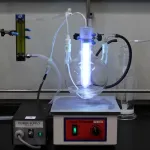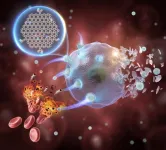Recent developments at MD Anderson include insights into the effects of the gut microbiome on remote tumors, a screening strategy for ovarian cancer early detection, a combination approach to overcome PARP inhibitor resistance, further understanding of ferroptosis resistance, a ferroptosis-based strategy for overcoming treatment resistance in acute myeloid leukemia (AML), potential targets for p53 mutations that lead to cancer progression, a signature for more accurately predicting risk in patients with AML given low-intensity treatments, and a prognostic tool to stratify patients with colorectal cancer.
Changes in gut microbiome may influence cancer growth in other parts of the body
Interleukin-17 (IL-17) signaling in the intestines maintains a healthy balance of gut microbes but also has been linked to several types of diseases, including cancer. However, IL-17 inhibition can interfere with the body’s ability to fight tumors, highlighting a need for further insights into this potential therapeutic target. In this study, researchers including Florencia McAllister, M.D., and Vidhi Chandra, Ph.D., found that deleting the IL-17 receptor specifically in the gut of lab models led to an imbalance of gut bacteria, or dysbiosis, which triggered an immune response and the growth of remote pancreatic and brain tumors. Adding antibiotics that eliminate the specific bacteria associated with pro-tumor behavior or deleting IL-17 receptors in all cancer cells reversed these effects. The results suggest that trials targeting IL-17 or other similar molecules should examine potential changes to the gut microbiome and consider using antibiotics or fecal microbial transplantation to maintain the microbial balance and improve treatment response. Learn more in Cancer Cell.
Long-term screening study shows promising predictive tool for ovarian cancer
The Normal Risk Ovarian Screening Study (NROSS) is a two-phase screening strategy for postmenopausal women who are considered at normal risk for ovarian cancer. The first phase uses a cancer antigen 125 (CA125) blood test and a Risk of Ovarian Cancer Algorithm (ROCA) to determine whether the second phase, a transvaginal sonography, is needed. Patients with an abnormal transvaginal sonogram would then be referred for surgery. A new analysis published by Robert Bast, M.D., Karen Lu, M.D., and colleagues shares NROSS results from the last two decades, including 7,856 women and 50,596 woman-years. A total of 34 patients received surgery: 15 with confirmed ovarian cancers, two with borderline early-stage ovarian tumors, seven with endometrial tumors and one with lung cancer. While the NROSS did not have a control arm like a similar UKCTOCS trial, 70% of ovarian cancers and borderline tumors detected were early stage (stage I-II), and the strategy had a positive predictive value of 50% for detecting ovarian cancer and 74% for detecting any cancer. The screening approach also reduced late-stage disease by 34% for ovarian cancer and by 30% for any cancer compared to the UKCTOCS and U.S. Surveillance, Epidemiology, and End Results (SEER) Program values. These results support further development of the NROSS strategy to improve patient outcomes. Learn more in the Journal of Clinical Oncology.
Combination strategy targeting protein methylation may improve PARP inhibitor activity
Inherited mutations in BRCA genes cause defects in DNA damage repair pathways. Targeted therapy with PARP inhibitors – which block a DNA repair protein – is known to extend progression-free survival in patients with BRCA-mutant cancers, but many patients eventually develop resistance and have poor overall survival, underscoring a need to identify combination strategies that improve outcomes. Protein arginine methyltransferases (PRMTs), which regulate gene transcription and RNA splicing, are involved in many cancer-associated processes, leading Nidhi Sahni, Ph.D., and colleagues to investigate PRMTs as potential therapeutic targets. Using targeted proteomics on cancer cell lines treated with PRMT inhibitors, the researchers discovered the key DNA replication stress response protein ATR also was suppressed. By combining PRMT and PARP inhibitors, they found that PRMT5 blockade preferentially suppressed ATR in cancer cells. Both in vitro and in vivo studies highlighted PRMT5 inhibition as a well-tolerated approach that merits further evaluation to improve treatment responses in patients given PARP inhibitors. Learn more in Cell Reports Medicine.
Connection found between cell-cycle arrest and ferroptosis resistance
Ferroptosis, a form of cell death involving fatty acids, can help eliminate cancer cells. However, some cancer cells develop treatment resistance and can proliferate slowly, leading to future tumor regrowth. To provide further insights, Boyi Gan, Ph.D., and colleagues examined the effects of cell cycle arrest on ferroptosis. Researchers found that cells that have slowed or arrested the cell cycle build up lipid droplets, allowing them to store fats that protect the cells against death. By combining a drug to prevent these droplets from forming with a compound that triggers ferroptosis, the researchers stopped growth of therapy-resistant tumors in preclinical models. These findings suggest this combination could be a promising new strategy against slow-proliferating, hard-to-treat cancer cells. Learn more in Nature Communications.
Study uncovers targets in cell death pathways to overcome treatment-resistant AML
Some patients with acute myeloid leukemia (AML) develop resistance to apoptosis, which can lead to relapse and a poor prognosis. Targeting ferroptosis, a different form of cell death, by inhibiting the GPX4 enzyme has shown preclinical therapeutic potential for other treatment-resistant cancers. To explore whether ferroptosis could work in refractory/relapsed AML, researchers led by Hiroki Akiyama, M.D., Ph.D., Michael Andreeff, M.D., Ph.D., and Jo Ishizawa, M.D., Ph.D., examined the molecular mechanisms of GPX4 inhibition to induce ferroptosis in AML cells. Inhibiting GPX4 activated ferroptosis both in vitro and in vivo, and the researchers discovered that mitochondrial respiration mechanisms largely regulate this process, potentially via a particular coenzyme in the mitochondria. Cells that do not make this coenzyme were more sensitive to GPX4 inhibition, suggesting that future studies should consider targeting mitochondrial regulation of ferroptosis to develop a novel ferroptosis-based therapy in AML. Learn more in Leukemia.
Study uncovers molecular pathways of TP53 mutations leading to cancer progression
The p53 protein, coded by the TP53 gene, plays an important role in suppressing tumors and preserving genomic stability. TP53 mutations not only inactivate p53 but also can cause mutant p53 activities that promote cancer development, yet the molecular pathways involved are not well understood. By studying mutant p53 molecular interactions, researchers led by Jeffrey Myers, M.D., Ph.D., and Ge Zhou, Ph.D., identified a specific target through which mutant p53 predisposes cells to chromosomal instability, promoting tumor cell metastasis and an immunosuppressive tumor microenvironment. This study also provides further insights into the molecular signaling pathways downstream of mutant p53-induced chromosomal instability that lead to the gain of tumor-driving functions. These data suggest targeting one of these pathways could be a potential therapeutic strategy. Learn more in Nature Communications.
Study validates risk prediction signature for low-intensity AML treatments
Many patients with acute myeloid leukemia (AML) are not candidates for intensive treatment and instead receive low-dose hypomethylating agents (HMAs) with venetoclax. However, the current European LeukemiaNet (ELN) risk classification system was designed to stratify patients receiving intensive treatment, underscoring a need to improve risk prognostication for patients given low-intensity HMAs and venetoclax. In this study, researchers led by Tapan Kadia, M.D., and Alex Bataller, M.D., retrospectively analyzed a novel molecular prognostic risk signature (mPRS) in 159 patients treated with HMA and venetoclax. The mPRS more accurately stratified patients into higher, intermediate and lower benefit groups with different response rates, survival times and relapse rates compared to the ELN. Additionally, patients with FLT3-ITD and RAS mutations had more unfavorable outcomes with HMA and venetoclax alone, and the results suggest that newer low-intensity backbones or adding FLT3 inhibitors could improve outcomes for patients in the mPRS intermediate group. The study validates the prognostic value of mPRS for patients with AML treated with HMA and venetoclax. Learn more in Blood Advances.
Study identifies potentially prognostic stemness signature in colorectal cancer tumors
Cancer stem cells (CSCs) from patients with colorectal cancer (CRC) are able to self-renew, regenerate and differentiate, playing a role in disease development and progression. While CSCs can be potential therapeutic targets, current methods to identify and sort them via known marker genes are limited by the ability of CSCs to transition back and forth between cell states. By performing single-cell RNA sequencing on CRC tumors and controls, researchers led by Kangyu Lin, Ph.D., Saikat Chowdhury, Ph.D., and John Paul Shen, M.D., identified a novel signature score for quantifying stemness that was more effective at identifying CSCs expressing all marker genes compared to using single gene markers. The study stressed the importance of considering C states over cell types, showing that the top 10% of stemness signature scores were associated with poorer disease-free survival after surgical resection. These findings suggest that high stemness is associated with relapse and highlight the prognostic potential of this trait. Learn more in Molecular Cancer Research.
Awards and honors
Betty Kim, M.D., Ph.D., professor of Neurosurgery, and Yinghong “Mimi” Wang, M.D., Ph.D., associate professor of Gastroenterology, Hepatology and Nutrition, have been elected to the American Society for Clinical Investigation. In case you missed it
Read below to catch up on recent MD Anderson press releases.
Vaccine demonstrates potential in delaying relapse of KRAS-mutated pancreatic and colorectal cancers Nidhi Sahni receives TAMEST Mary Beth Maddox Award for research in molecular pathways of cancer progression
- 30 -
END





